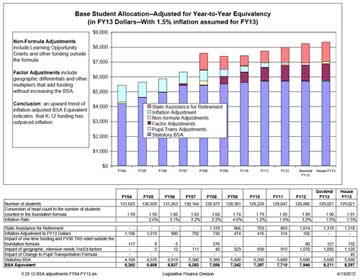
FISCAL YEAR 2013 K-12 EDUCATION PLAN ANNOUNCED
April 14, 2012
“The carefully-crafted package put together and approved by our membership showcases our commitment to both strive for accountability while also recognizing the importance of continuing to outpace inflation and smartly assess ways we can help districts ensure that as much of the foundation formula money as possible can make it into the classroom,” House Speaker Mike Chenault, R-Nikiski, said. “Our Finance co-chairs performed a nimble balancing act that should leave all parties satisfied with the proposed results.” The across-the-board plan incorporates specific pieces within Senate Bill 182, the capital budget and the operating budget. The new omnibus SB 182 includes:
“Those pieces in the new SB 182 alone total more than $42 million in additional aid to districts this year,” House Finance Committee Co-chair Bill Stoltze, R-Chugiak/Mat-Su, said. “These bills and targeted appropriations will help diversify student choices, promote workforce development and give municipalities the chance to decide whether to put the extra dollars in their back pockets or make an additional commitment to funding their schools.” The $42 million total is $12 million more than the governor’s proposed increase and the senate’s approved base student allocation (BSA) bill, and is equivalent increasing to formula funding by more than $150 per student. The House Majority also banded together to include $25 million more in the FY13 capital budget to go directly to Alaska schools, based on the foundation formula. “Caucus members banded together to prioritize education over personal projects in our capital budget,” Stoltze said. The package will front-load the legislature’s Public Education Fund with $86.7 million dollars to pay for the pieces through 2014. The new commitments for K-12 education come on the heels of the House’s approved FY 13 state operating budget, one quarter of which is spent on K-12 education, $1.53 billion in state funds. Education has been funded above inflation since 2004, according to the Legislative Finance Division, and the proposed K-12 funding being considered by the FY 13 operating budget conference committee and the Majority’s proposed K-12 package would mean that Alaska students are funded at 1.9 times the foundation formula, and have consistently been funded by more than 1.59 times since 2004. These numbers include state payments into the Teacher Retirement System (TRS) on top of their statutory amount, inflation adjustment dollars, changes to intensive needs funding, district cost factors, the pupil transportation components, major maintenance and a completed program raising the BSA $100 per year for three years. The proposed $329 million payment to TRS alone allows districts to use the money they would’ve had to put into retirement into other areas. The House operating budget also increases the department’s budget by $60 million and included funds for programs like Bright Beginnings and Parents as Teachers. “We’ve demonstrated our commitment to education this session, and over the past four years as a Majority,” House Finance Committee Co-chair Bill Thomas, R-Haines, said. “The operating investments in K-12 education carry the system forward and meet the needs of our districts. Before we decide on a BSA increase again we need to look at our future revenues and work with the education community to start boring down into the budget and performance factors on how best to invest the public’s money.” To that end, the House Finance Committee is going to put together an education working group led by the co-chairs to work over the interim. They’ll look at ways to increase student performance, review statutes concerning teacher retention and tenure, and ensure that our statutory framework provides support for teachers. They will also put our historical budget growth into context, and have conversations with educators and others about how the state is investing in education, and add funding to the operating budget for a two-year study into education delivery and effectiveness. “We’ve tried to delicately balance the existing needs of our education system with funding that continues to outpace inflation. We’re also going to work over the interim on ways to strengthen our education system and strike at our failing test scores and graduation rates,” House Majority Leader Alan Austerman, R-Kodiak, said. “Our caucus support for education is strong and we’ve been staunch advocates for delivering a quality education to Alaska students. This package and our operations budget shows that, and allows us to have an in-depth conversation with Alaskans going forward.” Source of News:
E-mail your news &
photos to editor@sitnews.us
|
|||
